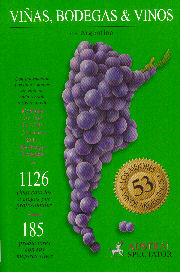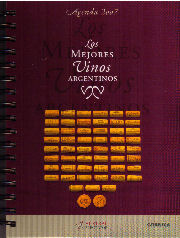Cuisine & Vins
November 2006, page 36
cuisine insider tips
Argentina for beginners
Orient Express-themed recommendations that you’ve probably never heard before in Buenos Aires. CUISINE&VINS best values.
The part of Palermo Viejo centered along the stretch of Avenida Córdoba between Avenida Scalabrini Ortiz and Avenida Justo is the center of the Árabe population of Buenos Aires. In this case, “arab” refers primarily to Armenians, a Middle Eastern influenced country that was formerly part of the Soviet Union. There’s also a Syrian, Lebanese, and Moroccan population that make up an important, but smaller portion of the populace.


There are numerous Middle Eastern style restaurants located in Palermo Viejo, ranging from cheap takeout counters to elegant white tablecloth dining rooms. For truly authentic Armenian cuisine there are two that vie for top honors. The long time reigning champion of the zone is Sarkis, Thames 1101, 4772-4911. Despite the white linens on the tables, Sarkis is a casual spot for lunch or dinner, offering up tasty renditions of everything from the best hummus and tabouleh in town to excellent lamb or beef kofta. The wine list isn’t overly exciting – mostly the big name usual suspects, but for the most part, beer goes better with this food anyway. Spectacularly good bakhlava and excellent café arabe are a great way to finish up the meal. It’s also a complete bargain. Sarkis’ only real competition for outstanding Armenian food is the nearby El Manto, Costa Rica 5801, 4774-2409, where a shorter menu of traditional dishes served up with a touch of mysticism is offered. Their claim is that their recipes date back generation by generation to the year 301 A.D. when their family village was established. The atmosphere is a bit surreal, with nearly silent waiters moving through the dark, burgundy and black room, while fantasy music plays in the background. Very good renditions of classic dishes are offered, along with a decent selection of wines. Coffee the viscosity of sand is served, and a fortune teller is on hand to read you’re the grounds after you’ve sucked whatever moisture you can from the brew. A bit pricier than Sarkis, but it has the advantage of an elegant and soothing atmosphere.

From another whole part of the Middle East is the food at Cheff Iusef, Malabia 1378, 4773-0450. The original owner is from Lebanon, where, if I understood the conversation correctly, his grandfather was the Gran Rabino of the Jewish community in Beirut. The staff and the food are a mix of Lebanese and Syrian. Definitely different in style from the more common Armenian restaurants in the area, with more varied spices and herbs used. The room was at one time very elegant, but now is starting to show a bit of tatter. The extensive menu offers a wide selection of dishes, and the wine list is well stocked with more offbeat selections. While there are some really good versions of standards like falafel (unusually flavored with cinnamon) or tabouleh (more of an herb salad than the usual grain-based version), where Cheff Iusef shines is its house specialties, especially the enormous football shaped kebbe de levanie, or Lebanese kebbe, a cooked wheat berry and lamb oblong in a yogurt, cucumber, and mint sauce; and possibly the best pistachio bakhlava I’ve ever had.
 The flavors of Middle Eastern food call out for a somewhat lighter red with lots of fruit, spice, and acidity. While not new to the Argentine wine scene, the country isn’t well known for its Barberas. A classic grape from the Piemonte and surrounding areas in Italy, the grape was brought over nearly a century ago by Italian immigrants. While for most of its time here its been used as a blending grape, in the last decade or so more and more producers have recognized the same potential that their ancestors in the old country saw. One of the best, and a bargain to boot, is Familia Adrover Barbera 2001 – also one of the few still on the market with a little age on it. This is a small family winery that literally makes three different wines between two large lined concrete tanks – one for Barbera and one for Cabernet (their third wine is a blend of the two). The wine is lively, bright, full of ripe berry fruit flavors, with a touch of leather and lots of spice – notably clove and mace. It will run you somewhere around 20-25 pesos in local shops.
The flavors of Middle Eastern food call out for a somewhat lighter red with lots of fruit, spice, and acidity. While not new to the Argentine wine scene, the country isn’t well known for its Barberas. A classic grape from the Piemonte and surrounding areas in Italy, the grape was brought over nearly a century ago by Italian immigrants. While for most of its time here its been used as a blending grape, in the last decade or so more and more producers have recognized the same potential that their ancestors in the old country saw. One of the best, and a bargain to boot, is Familia Adrover Barbera 2001 – also one of the few still on the market with a little age on it. This is a small family winery that literally makes three different wines between two large lined concrete tanks – one for Barbera and one for Cabernet (their third wine is a blend of the two). The wine is lively, bright, full of ripe berry fruit flavors, with a touch of leather and lots of spice – notably clove and mace. It will run you somewhere around 20-25 pesos in local shops.
 One of the most well known bodegas in Argentina is Gascon. Their wines are marketed in several ranges, from cheap table wine, to their family varietals, to their newest venture, the handpicked and crafted Pequeños Producciones. The 2002 Miguel Escorihuela Gascon Barbera from this line is simply spectacular, a bold, spicy Barbera, with lots of red fruit, a dollop of vanilla from the oak, excellent balance, and a long, lingering finish. This wine will set you back around 75 pesos in a shop, probably well over 100 in a restaurant, but it’s worth every penny.
One of the most well known bodegas in Argentina is Gascon. Their wines are marketed in several ranges, from cheap table wine, to their family varietals, to their newest venture, the handpicked and crafted Pequeños Producciones. The 2002 Miguel Escorihuela Gascon Barbera from this line is simply spectacular, a bold, spicy Barbera, with lots of red fruit, a dollop of vanilla from the oak, excellent balance, and a long, lingering finish. This wine will set you back around 75 pesos in a shop, probably well over 100 in a restaurant, but it’s worth every penny.
Neither Middle Eastern nor Asian markets are commonplace in Buenos Aires. But one thing that not only visitors, but often longtime residents, are surprised to find out is that the capital boasts some small, but true “ethnic” neighborhoods. The area surrounding Avenidas Córdoba and Scalabrini Ortiz is home to a large portion of the Middle Eastern population here. Not just restaurants, but shops abound, with some of the best centered right near that intersection. Probably the best known in the area are Medio Oriente, Avenida J.A. Cabrera 4702, at Malabia and Damascus, Avenida Scalabrini Ortiz 1283. The latter is one of the few places in Buenos Aires where you can buy unsweetened yogurt – they offer both a light version and the heavier labneh style.
Barrio Chino, in Belgrano, as it’s called, is primarily a residential zone, with a several block commercial stretch along Arribeños just north of Avenida Juramento and the Belgrano “C” train station. The area is home to numerous decent Chinese restaurants (primarily Taiwanese cuisine) as well as food markets. Further off the beaten track is Coreatown, in the south part of Barrio Flores. Here, a half dozen block commercial stretch along Avenida Carabobo, between Avenidas Castañeres and Eva Perón is home to multiple Korean food markets and restaurants serving up good quality traditional fare.
In October 2006, I started writing for this Spanish language magazine, covering their English language section for travellers. I wrote for them for about two years. The copy editor, apparently not fluent in English, used to put each paragraph in its own text box on a two column page, in what often seemed to be random order, making the thread of the column difficult to follow. I’ve restored the paragraphs to their original order.











